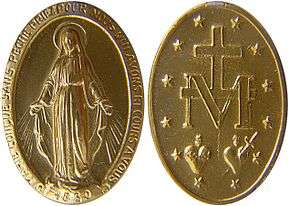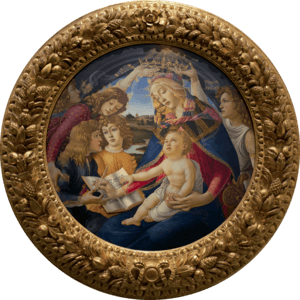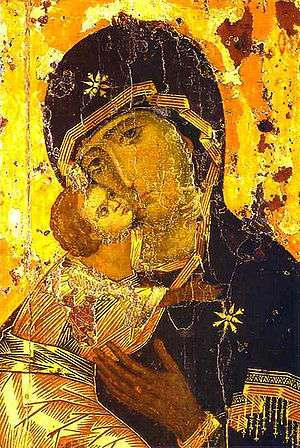Miraculous Medal
| Our Lady of the Miraculous Medal of the Immaculate Conception | |
|---|---|
|
The Miraculous Medal design was executed by Adrien Vachette | |
| Location | Paris, France |
| Date |
19 July 1830 27 November 1830 |
| Witness | Saint Catherine Labouré |
| Type | Marian apparition |
| Holy See approval | 1895, during the pontificate of Pope Leo XIII |
| Shrine | Chapel of Our Lady of the Miraculous Medal, Paris, France |
| Patronage | Special graces, architects, miners, prisoners |
The Miraculous Medal (French: Médaille miraculeuse), also known as the Medal of the Immaculate Conception, is a medal, the design of which was originated by Saint Catherine Labouré following her vision of the Blessed Virgin Mary[1][2] and made by goldsmith Adrien Vachette.
Although not an official teaching of the Catholic Church, some Catholics believe that wearing the medal with faith and devotion can bring special graces through the intercession of Mary.[1][2]
Background
Catherine Labouré stated that on July 18, 1830, the eve of the feast of St. Vincent, she woke up after hearing the voice of one child calling her to the chapel, where she heard the Virgin Mary say to her, "God wishes to charge you with a mission. You will be contradicted, but do not fear; you will have the grace to do what is necessary. Tell your spiritual director all that passes within you. Times are evil in France and in the world."[3]
On November 27, 1830, Catherine reported that the Blessed Mother returned during evening meditations. She displayed herself inside an oval frame, standing upon a globe. She wore many rings set with gems[4] that shone rays of light over the globe. Around the margin of the frame appeared the words Ô Marie, conçue sans péché, priez pour nous qui avons recours à vous ("O Mary, conceived without sin, pray for us who have recourse to thee"). As Catherine watched, the frame seemed to rotate, showing a circle of twelve stars, a large letter M surmounted by a cross, and the stylized Sacred Heart of Jesus crowned with thorns and Immaculate Heart of Mary pierced with a sword. Asked why some of the gems did not shed light, Mary reportedly replied, "Those are the graces for which people forget to ask." Catherine then heard Mary ask her to take these images to her father confessor, telling him that they should be put on medallions, and saying "All who wear them will receive great graces."[5]
Catherine did so, and after two years of investigation and observation of Catherine's ordinary daily behavior, the priest took the information to his archbishop without revealing Catherine's identity. The request was approved and medallions were designed and produced through goldsmith Adrien Vachette.[6][7]
The chapel in which Saint Catherine experienced her visions is located at the mother house of the Daughters of Charity in Paris.[8] The incorrupt bodies of Saint Catherine Labouré and Saint Louise de Marillac, a co-founder of the Daughters of Charity, are interred in the chapel, which continues to receive daily visits from Catholic pilgrims today.
Pope John Paul II used a slight variation of the reverse image as his coat of arms, the Marian Cross, a plain cross with an M underneath the right-hand bar (which signified the Blessed Virgin at the foot of the Cross when Jesus was being crucified).
Properties of the medal
According to the verbal process of the investigation on February 16, 1836, the medal is supposed to be oval in shape. It also bears the words, "O Mary! conceived without sin, pray for us who have recourse to thee!"; these start at Mary's right hand, continue over her head, and end at her left hand.[9]
According to an account written by Catherine's own hand, Mary was clothed in a robe of auroral light and her robe had a high neck and plain sleeves. According to Catherine's notes, the medal should also have half a globe upon which Mary's feet rest, hands raised up to her waist, fingers giving off rays of light, and a frame slightly oval with golden letters saying, "O Mary! conceived without sin, pray for us who have recourse to thee!" [9]
See also
- Alliance of the Hearts of Jesus and Mary
- Chapel of Our Lady of the Miraculous Medal
- Marian Cross
- Sanctuary of the Miraculous Medal and St. Augustine
- Stabat Mater (art)
- St. Benedict Medal
References
- Alma Power-Waters, 2000, St. Catherine Labouré and the Miraculous Medal, Ignatius Press, ISBN 978-0-89870-765-6
- Saint Catherine Labouré of the Miraculous Medal, by Joseph I Dirvin, CM, TAN Books and Publishers, Inc, 1958/84. ISBN 0-89555-242-6
- Association of the Miraculous Medal
- Rene Laurentin, "Catherine Laboure: Visionary of the Miraculous Medal," Pauline books and Media, Boston, 2006, ISBN 0-8198-1578-0.
Notes
- 1 2 Ann Ball, 2003 Encyclopedia of Catholic Devotions and Practices ISBN 0-87973-910-X p. 356
- 1 2 Mark Miravalle, 1993, Introduction to Mary ISBN 978-1-882972-06-7, pp. 190-191
- ↑ Dirvin, C.M., Joseph I. (1958). Saint Catherine Laboure of the Miraculous Medal. Tan Books & Publishers, Inc. ISBN 0-89555-242-6.
- ↑ " I saw rings on her fingers, three rings to each finger, the largest one near the base of the finger, one of medium size in the middle, the smallest one at the tip. Each ring was set with gems, some more beautiful than others..." Catherine Labouré, quoted in John Delaney, A Woman Clothed With The Sun, Doubleday, 1960, p. 77.
- ↑ Glass, Joseph. "Miraculous Medal." The Catholic Encyclopedia. Vol. 10. New York: Robert Appleton Company, 1911. 20 Dec. 2012
- ↑ McMenamin, M. 2010. Precisely dated early versions of the Miraculous Medal. Numismatics International Bulletin, v. 45, nos. 3/4, p. 43-48.
- ↑ Mack, John (2003). The museum of the mind: art and memory in world cultures. British Museum.
- ↑ Mauriello, Rev. Matthew R. (1996). "The Miraculous Medal". Fairfield County Catholic. Retrieved 21 December 2012.
- 1 2 Aladel, M. (1999). The Miraculous Medal. Albany, New York: Preserving Christian Publications, Inc. pp. 49–51.
External links
- Chapel of the Miraculous Medal – the site of the visitations and the resting place of Saint Catherine
- The Miraculous Medal – free distribution of the Miraculous Medal in the world
Coordinates: 48°51′04″N 2°19′26″E / 48.850974°N 2.323770°E




